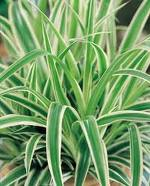SPIDER PLANT
Chlorophytum comosum

THE EVERYTHING PLANT
I’m just a spider plant but in my dreams
I’m a ………..
Moody volcano erupting madly;
Fountain spitting its contents all over the world;
Bubbling Swamp shooting green slime;
Burning bush fizzing;
Jellyfish stinging all the fish in the ocean;
Sizzling sparklers spreading out colours.

AIR PURIFICATION
The National Aeronautic and Space Administration (NASA), which tested the abilities of three common houseplants to remove formaldehyde from the air, found in preliminary tests that spider plants were the champs, removing 95 percent of the toxic substance from a sealed Plexiglas chamber in 24 hours.
CARE
LIGHT: Medium to high, but no direct afternoon sunlight.
WATER: Water thoroughly and let dry out between waterings. Don’t overwater them. It can lead to rot.
TEMPERATURE: Cool, medium, warm. They are happiest in the same temperatures that make you comfortable. Don’t let the temperature go below 40ºF or they will be damaged.
HUMIDITY: High. Spider plants find our homes too dry in winter and need to be misted frequently indoors to prevent attacks by spider mites.
FERTILIZER: Fertilize every 2 months. Don’t overfertilize.
SOIL MIX: 1 part sterilized garden loam, 1 part clean coarse sand or Perlite, and 1/2 to 1 part sphagnum peat moss. Spider plants need a good peat-based potting soil with some added loam for plant stability.
PROPOGATION: Division, plantlets. It should be repotted whenever the fat white roots fill the pot and make watering difficult. Place a plantlet on the surface of the soil in its new home. Plantlets may be submerged in an aquarium for a few days to hydrate them prior to potting …. They love this.
PROBLEMS
BROWN TIPS ON THE LEAVES – Spider plants are sensitive to the chemicals in tap water. It should always be watered with distilled water, rain water, reverse osmosis water, melted snow or water collected from a dehumidifier. Once you have changed the water source, all the new leaves should be normal, but you will have to trim the brown tips off the old leaves.
FERTILIZER BURN – Leach pot 3 times with water between fertilizer applications.
BROWN SCORCH MARKS – This is usually the result of using leafshine products on spider plants. They do not tolerate these products well.
PLANT LOOKS FLOPPY AND WEAK – It may need to be fertilized. When it is producing flowers or plantlets it should be fed every two weeks with a water soluble fertilizer.
PLANT IS ROTTING IN THE CENTER – Rot is caused by overwatering. Spider plants should be allowed to dry out before being re-watered. If rot has begun, the plant may die. You can try to salvage the plant by removing it from its container and dividing it. Discard the rotten part and repot the healthy parts in a clean container with new soil.
PLANT IS LOSING ITS VARIEGATION – It needs more light. Move it to a brighter spot without direct sunlight. If you are using artificial light for the plant, lengthen the number of hours the lights are on to 12 or more.
LEAVES SUDDENLY BECOME TRANSPARENT AND SOFT – The plant has become too cold. Move it to a warmer area. If the roots didn’t freeze, you may be able to trim off the damaged foliage and let it regrow.
SCALE INSECTS – Scrape off. Isolate.
WEBS UNDER THE LEAVES AND THE LEAVES LOOK DULL AND ROUGH – Your plant has spider mites. They attack when the air is hot and dry. Spray the plant with insecticidal soap or horticultural oil. You may have to repeat the process after 3 or 4 days, and maybe a third time to regain control. Mist the plant more often to discourage their return.
EATING THE EDGES OF THE LEAVES – The culprit is probably greenfly. Spray the plant with insecticidal soap and repeat in two weeks. Cut off the damaged leaves at the soil line.